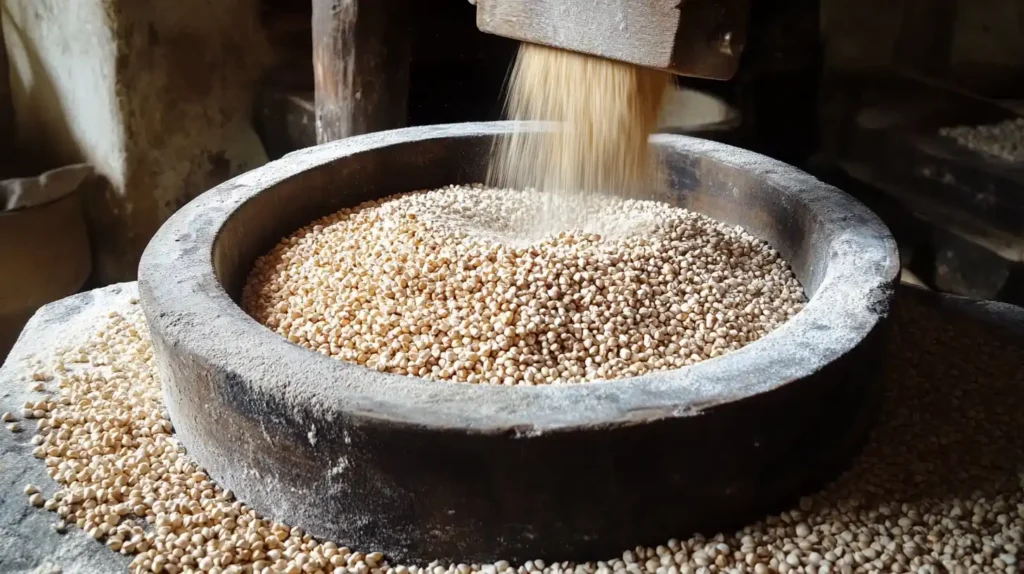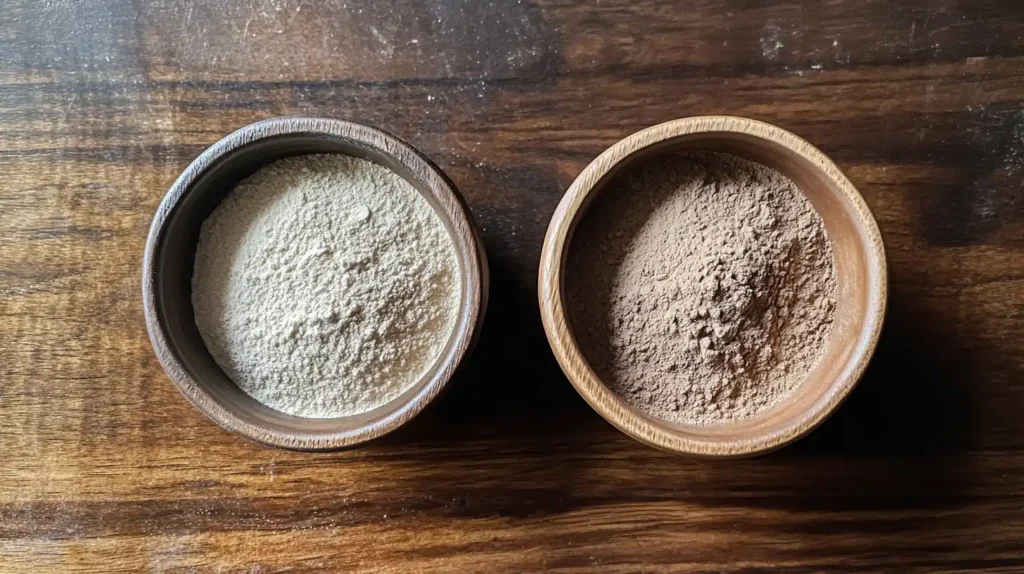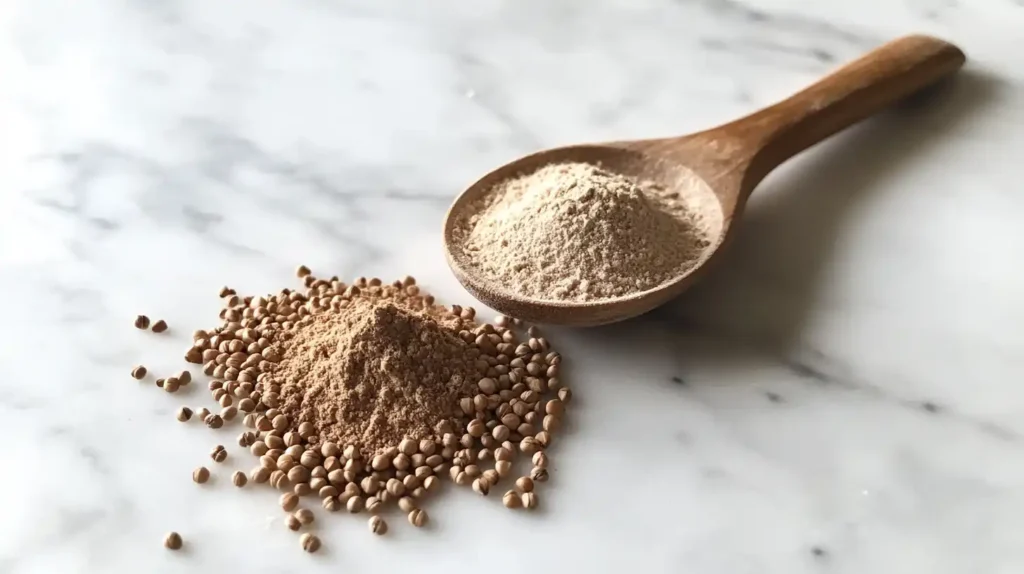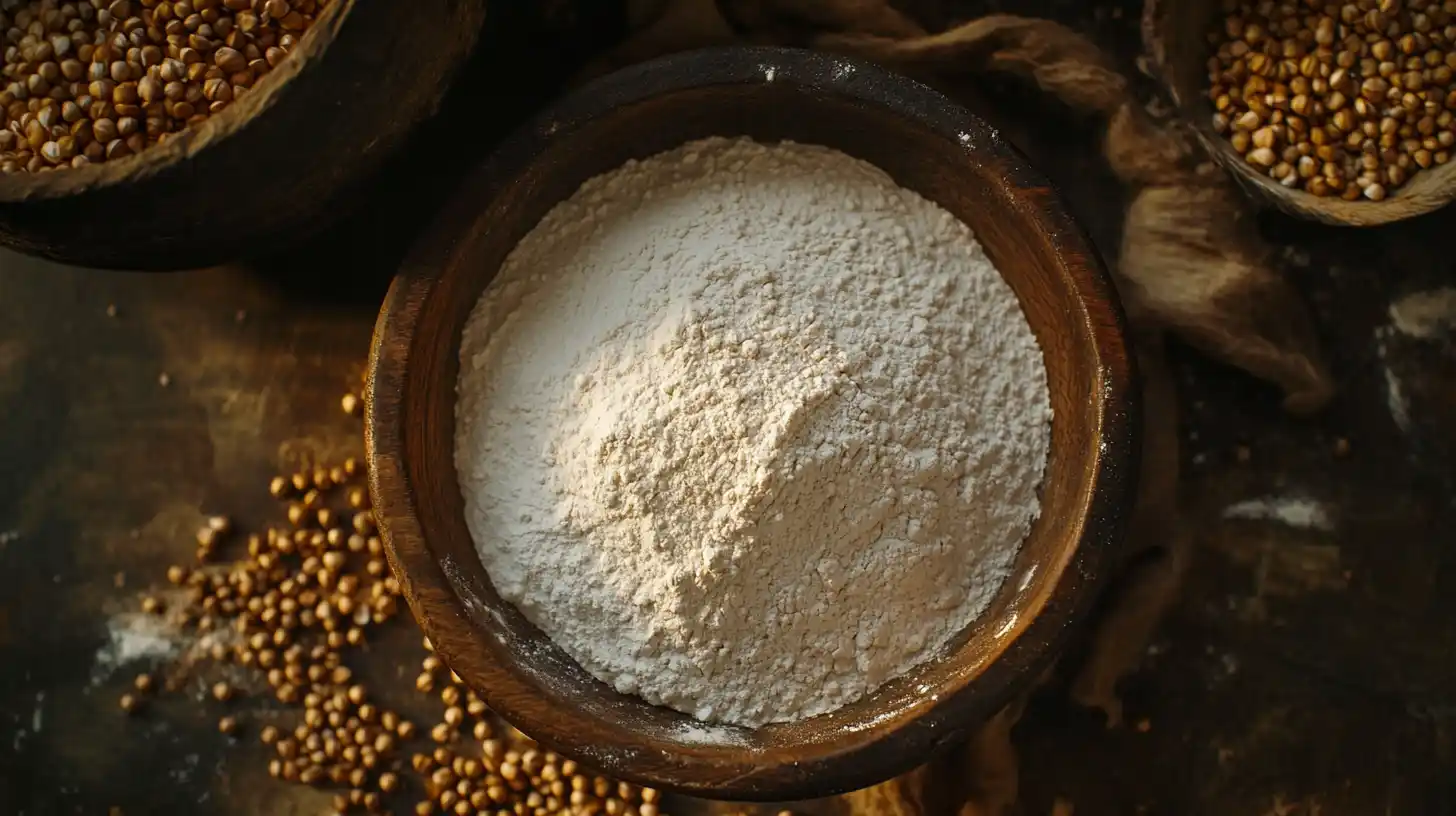Many people wonder, is buckwheat flour just ground buckwheat? The simple answer is yes, but it’s not that straightforward. Buckwheat flour comes from grinding buckwheat groats, yet the type of buckwheat used and how it’s processed can change its taste, texture, and nutrition.
Unlike wheat, buckwheat is a pseudo-grain, which means it acts like a grain in cooking but is actually a seed. This makes it naturally gluten-free. Many people use it in baking, noodles, and pancakes. If you want to make buckwheat flour at home, you can follow this simple guide.
Since buckwheat flour has a unique taste and texture, it’s good to know how different types work in recipes. Understanding its types, uses, and benefits will help you make the most of it in your kitchen.
Table of contents
What Is Buckwheat?
To understand buckwheat flour, it helps to know what buckwheat is. Many people think it’s a type of wheat, but that’s not true. In fact, buckwheat is a pseudo-grain, which means it acts like a grain but is actually a seed.
A Pseudo-Grain with Ancient Roots
- Buckwheat is not related to wheat. Instead, it belongs to the rhubarb and sorrel family.
- It has been grown for thousands of years, especially in Asia and Eastern Europe.
- Unlike wheat or rice, buckwheat does not grow on grass. Instead, it comes from a flowering plant.
- Its seeds, known as buckwheat groats, are used in cooking or ground into flour.
Because buckwheat is not a grain, it is naturally gluten-free, making it a great choice for people with gluten intolerance or celiac disease.
Nutritional Benefits
Buckwheat is not just a flour alternative; it’s also packed with nutrients. Here’s why people love it:
- High in fiber – Helps with digestion and gut health.
- Rich in plant-based protein – A great choice for vegetarians and vegans.
- Full of antioxidants – Contains rutin, which may help support heart health.
- Low glycemic index – Can help control blood sugar levels.
- Gluten-free – Perfect for those who need to avoid wheat-based products.
Because of these health benefits, buckwheat is used in many traditional dishes around the world, including Japanese soba noodles, Russian blinis, and French galettes. If you want to learn more about baking with buckwheat flour, check out this helpful guide.
How to Use This Versatile Flour?
The process of turning buckwheat groats into buckwheat flour involves several steps:
- Harvesting – The buckwheat plant is grown and harvested when the seeds (groats) are fully mature.
- Hulling – Some buckwheat flours are made from hulled buckwheat groats, meaning the dark outer shell has been removed. Others include the hull, which creates a darker flour with a richer flavor.
- Roasting (Optional) – Some groats are roasted before grinding. This creates a stronger, nuttier taste, commonly known as kasha flour.
- Grinding – The groats are ground into a fine or coarse powder using a stone mill or an industrial grinder.
- Sieving – Some flours are sifted to remove larger particles, making them smoother and finer.
While all buckwheat flour comes from ground buckwheat groats, the way they are processed determines the color, texture, and taste of the flour.

Types of Buckwheat Flour
Not all buckwheat flour is the same. There are several types, each with unique characteristics:
1. Light Flour
- Made from hulled buckwheat groats (groats with the outer shell removed).
- Has a light color and a milder flavor.
- Best for cakes, muffins, and delicate baked goods.
2. Dark Flour
- Made from whole, unhulled buckwheat groats (includes the outer shell).
- Has a darker color and a stronger, earthier flavor.
- Used for traditional buckwheat pancakes, hearty breads, and rustic baking.
3. Toasted vs. Untoasted Buckwheat Flour
- Toasted buckwheat flour (also known as kasha flour) has a nutty and bold flavor.
- Untoasted buckwheat flour has a milder, more neutral taste.
- The choice depends on whether a strong or subtle buckwheat flavor is preferred in a recipe.
Because of these differences, selecting the right type of buckwheat flour is important for achieving the best results in cooking and baking.

Is Homemade Buckwheat Flour the Same as Store-Bought?
Homemade buckwheat flour is often made by grinding raw buckwheat groats in a high-speed blender or grain mill. This method allows for freshness and control over texture, but it may not be as fine as commercially milled flour.
Store-bought buckwheat flour, on the other hand, is often processed on a large scale, ensuring consistent texture and better baking results. Some brands also blend light and dark flours to create a balanced flavor.
Key Differences Between Ground Buckwheat and Buckwheat Flour
| Feature | Ground Buckwheat Groats | Buckwheat Flour |
|---|---|---|
| Processing | Whole groats ground at home | Milled commercially for a fine texture |
| Texture | Can be coarse or fine | Usually smoother and finer |
| Types Available | Raw or toasted | Light, dark, toasted, or blended |
| Best Used For | Hot cereals, porridges | Baking, noodles, pancakes |
Both ground buckwheat and buckwheat flour can be used in cooking, but choosing the right one depends on the recipe.
How to Use Buckwheat Flour
Because buckwheat flour does not contain gluten, it behaves differently from wheat flour. Here are some of the best ways to use it:
Baking Tips for Better Results
- Works well in pancakes, muffins, and cookies.
- Has a dense, slightly grainy texture, so mixing it with other flours improves consistency.
- Adds a rich, nutty flavor to baked goods.
Adding It to Savory Dishes
- Soba noodles (Japanese buckwheat noodles) rely on this flour.
- Acts as a thickener for soups and sauces.
- Enhances homemade tortillas or flatbreads with its earthy flavor.
A Reliable Gluten-Free Alternative
- Used as a thickener for soups and sauces.
- Works well in gluten-free flatbreads and tortillas.
- Can be used in protein-rich pancake recipes like these protein blueberry pancakes.
Health Benefits You Should Know
Why Is Buckwheat Flour a Healthy Choice?
Buckwheat flour is full of essential nutrients, making it a healthier option compared to refined white flour. Here’s why it stands out:
- High in Fiber – Fiber helps with digestion by keeping the gut healthy and preventing constipation. A diet high in fiber can also help with weight management by keeping you full for longer.
- Rich in Plant-Based Protein – Buckwheat flour contains more protein than many other gluten-free flours, making it a great choice for vegetarians and vegans. It also provides essential amino acids that help build muscles and repair tissues.
- Packed with Antioxidants – Buckwheat flour is high in rutin, a powerful antioxidant that may help improve circulation and reduce inflammation in the body. Antioxidants also help protect cells from damage caused by free radicals.
- Naturally Gluten-Free – Since buckwheat is not related to wheat, it does not contain gluten, making it a safe option for people with celiac disease or gluten sensitivities.
- Supports Heart Health – The combination of fiber, antioxidants, and plant-based protein in buckwheat flour may help lower bad cholesterol levels, reducing the risk of heart disease.
- Stabilizes Blood Sugar – Buckwheat has a low glycemic index, meaning it does not cause a rapid spike in blood sugar levels. This makes it a great option for people with diabetes or those looking to maintain steady energy levels.

Comparing Buckwheat Flour to Other Flours
How does buckwheat flour compare to other common flours?
- Buckwheat Flour vs. Wheat Flour – Buckwheat flour is gluten-free and contains more fiber and antioxidants than refined wheat flour. However, wheat flour has gluten, which helps baked goods rise.
- Buckwheat Flour vs. Almond Flour – Both flours are gluten-free and rich in nutrients. Almond flour is higher in healthy fats, while buckwheat flour has more fiber and protein.
- Buckwheat Flour vs. Rice Flour – Rice flour is light and neutral in taste but lacks the fiber and protein found in buckwheat flour. Buckwheat flour is more nutrient-dense and provides better texture in some baked goods.
Who Should Eat Buckwheat Flour?
- People with Gluten Intolerance – Since buckwheat flour is gluten-free, it is an excellent choice for those who cannot eat wheat.
- Vegetarians and Vegans – The high protein content in buckwheat flour makes it a great plant-based protein source.
- People with Diabetes – Because it has a low glycemic index, buckwheat flour helps keep blood sugar levels stable.
- Anyone Looking for a Nutritious Alternative – If you want to add more fiber, protein, and antioxidants to your diet, buckwheat flour is a smart choice.
Buckwheat flour is not just for people on a gluten-free diet. It is a great addition to any healthy eating plan because of its impressive nutrient profile and health benefits.
FAQs: Everything You Need to Know
Many people have questions about buckwheat flour, especially because it is a unique, gluten-free alternative to traditional flours. Below are some of the most frequently asked questions, along with clear and simple answers.
1. Is Buckwheat Flour the Same as Ground Buckwheat Groats?
Not exactly. While buckwheat flour is made from ground buckwheat groats, the type of buckwheat used and the way it is processed can make a difference.
- Ground buckwheat groats can be coarse or fine, depending on how they are blended.
- Buckwheat flour is finely milled and often sifted to ensure a smooth texture for baking.
- Some commercial flours may be roasted before grinding, giving them a stronger flavor.
If you want to make your own buckwheat flour at home, you can use a blender or grain mill to grind raw groats into a fine powder.
2. Can Buckwheat Flour Be Used Instead of Regular Flour?
Yes, but with some adjustments. Since buckwheat flour does not contain gluten, it does not provide the same elasticity as wheat flour.
- In baking, it is best to replace 25-50% of wheat flour with buckwheat flour to maintain structure.
- In gluten-free recipes, it can be mixed with other flours like almond flour, oat flour, or tapioca starch to improve texture.
- It works well in pancakes, muffins, cookies, and crepes but may need binders like eggs, xanthan gum, or chia seeds for structure.
3. Does Buckwheat Flour Contain Gluten?
No. Buckwheat flour is naturally gluten-free, making it a safe choice for people with celiac disease or gluten sensitivities. However, some store-bought flours may be processed in facilities that handle wheat, so it’s always best to check the label for certified gluten-free options.
4. What Does Buckwheat Flour Taste Like?
Buckwheat flour has a nutty, earthy, and slightly bitter flavor. The taste can vary depending on the type of buckwheat flour:
- Light buckwheat flour (made from hulled groats) has a mild, slightly sweet flavor.
- Dark buckwheat flour (made from whole groats with the hull) has a stronger, earthier taste.
- Toasted buckwheat flour has a richer, roasted flavor, often used in traditional Eastern European dishes.
The taste pairs well with chocolate, honey, nuts, cinnamon, and berries, making it a great choice for both sweet and savory recipes.
5. How Should Buckwheat Flour Be Stored?
Since buckwheat flour contains natural oils, it can spoil faster than refined flours. To keep it fresh:
- Store it in a cool, dry place in an airtight container.
- Keep it in the refrigerator to extend its shelf life to 6 months.
- For long-term storage, freeze it in a sealed bag or container for up to 1 year.
Proper storage helps prevent rancidity and keeps the flour fresh for baking.
6. Can Buckwheat Flour Go Bad?
Yes, like all whole grain flours, buckwheat flour can become rancid if not stored properly. Signs that it has gone bad include:
- A sour or musty smell
- A bitter taste
- Clumps or moisture in the flour
If you notice any of these, it’s best to discard the flour and buy a fresh batch.
7. Is Buckwheat Flour Good for Weight Loss?
Yes! Buckwheat flour is high in fiber and protein, which helps keep you full longer and reduces hunger cravings. It also has a low glycemic index, meaning it digests slowly and helps maintain stable blood sugar levels.
For best results, use it in:
- Whole grain pancakes or crepes
- High-fiber muffins or bread
- Smoothies or protein-rich baked goods
Combining buckwheat flour with healthy fats and proteins can make meals even more satisfying.
8. Can Buckwheat Flour Be Used for Bread?
Yes, but since it lacks gluten, it works best in gluten-free bread recipes or when mixed with other flours.
For better results:
- Combine it with tapioca flour, rice flour, or almond flour.
- Use eggs, flaxseeds, or xanthan gum as binders.
- Try recipes that include yeast or baking powder to help the bread rise.
It is commonly used in hearty, rustic breads rather than soft sandwich breads.
9. What Are the Side Effects of Consuming Buckwheat Flour?
Buckwheat flour is safe for most people, but there are a few things to consider:
- Some people may have a buckwheat allergy, which can cause mild to severe reactions.
- Since it is high in fiber, eating too much too quickly can cause bloating or gas.
- It has a distinct taste, which some people may find too strong in large amounts.
If you are new to buckwheat flour, start with small amounts to see how your body reacts.
10. What’s the Difference Between Homemade and Store-Bought Buckwheat Flour?
Homemade buckwheat flour is made by grinding raw or toasted buckwheat groats in a blender or grain mill.
| Feature | Homemade Buckwheat Flour | Store-Bought Buckwheat Flour |
|---|---|---|
| Processing | Freshly ground at home | Milled in factories for fine texture |
| Texture | Can be coarse or fine | Usually smooth and consistent |
| Varieties | Raw or toasted | Light, dark, or blended |
| Shelf Life | Shorter, needs refrigeration | Longer, if stored properly |
If you prefer fresh flour, making it at home is a great option. However, for consistent texture and baking results, store-bought flour may be more convenient.
Conclusion
After exploring the different aspects of buckwheat flour, it is clear that while it is made from ground buckwheat groats, there are important differences in how it is processed and used. The type of buckwheat, the milling method, and whether it is toasted or raw all affect its flavor, texture, and nutritional profile.
Unlike regular wheat flour, buckwheat flour is naturally gluten-free, making it a great option for people with celiac disease or gluten sensitivities. It also provides more fiber, protein, and antioxidants than refined flours, making it a healthy alternative for anyone looking to improve their diet.
Key Takeaways
- Buckwheat flour is made by grinding buckwheat groats, but the type of groats used (hulled, unhulled, raw, or toasted) changes the final flour.
- There are different types of buckwheat flour, including light, dark, and toasted varieties, each suited for different recipes.
- Buckwheat flour does not contain gluten, so it behaves differently in baking and often needs to be mixed with other flours.
- It has a nutty, earthy flavor, which works well in both sweet and savory dishes, including pancakes, bread, soba noodles, and cookies.
- Buckwheat flour is rich in fiber, protein, and antioxidants, making it a healthier alternative to many other flours.
- Proper storage is important because buckwheat flour contains natural oils that can turn rancid if not kept in a cool, dry place or in the refrigerator.

